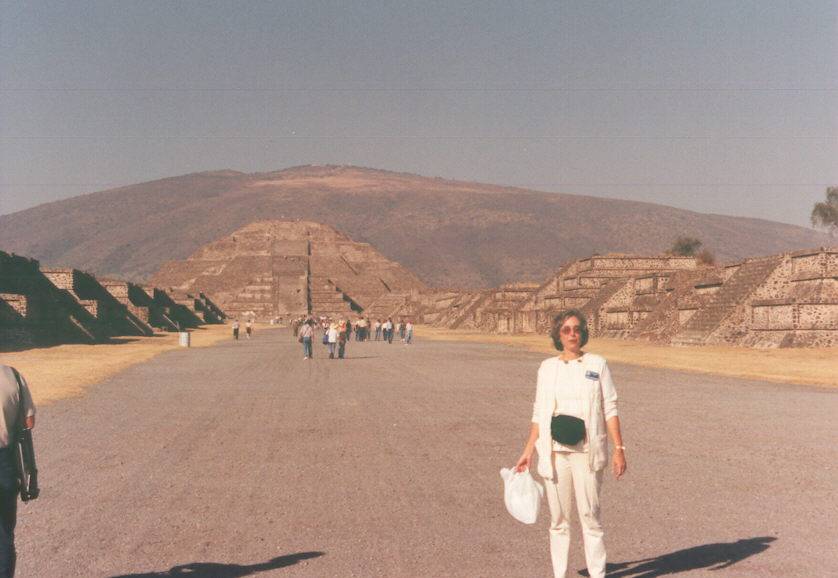"Higher Things" - Teotihuacan: City of the Birth of the Gods
"Higher Things" - Teotihuacan: City of the Birth of the Gods
by William J. Hamblin and Daniel C. Peterson

Measuring 9200 meters square and 66 meters high, the four massive tiers of the pyramid can be climbed by means of a monumental stairway on the west. It was designed for astronomical observations, worship, and sacrifice. The entire structure seems to have symbolized the cosmic mountain of creation, which one ascends to the presence of the gods. In the sixteenth century an eighteen-foot tall idol -- probably similar to the "Atlantes" of Tula -- stood in the ruined temple complex at the top. This image was still worshipped by pilgrims but was destroyed by the conquistadors in an attempt to obliterate the Aztec religion. In front of the Pyramid of the Sun, on a roughly north-south axis, runs the three-mile long, forty-yard wide "Avenue of the Dead" (Miccaotli). The entire sacred way is interspersed with half-a-dozen small plazas, and is lined on both sides with dozens of small stepped pyramids, temples, altars and apartment complexes for the priests or other elite groups.
The northern part of the Avenue of the Dead ends in the plaza and pyramid of the Moon, associatedby the Aztecs with the moon and water goddess chalchiuhtlicue. Although only 46 meters high, it is divided into four massive tiers surmounted by a monumental south-facing stairway. Many of the smaller pyramids and buildings surrounding the plaza of the Moon contain splendid carvings and fresco murals depicting jaguars, serpents, butterflies, eagles, and ornately attired priests. As with the other temples and pyramids of Teotihuacan, the precise rites and beliefs associated with these structures is unknown. The southern Avenue of the Dead culminates in a structure the Spanish believed was a "citadel" (ciudadela), but is now thought to have been a market or ceremonial complex. It contains the splendid seven-tiered, temple-pyramid of Quetzalcoat. Built in the second century AD, it is ornamented with numerous representations of the feathered-serpent. Although Quetzalcoattl symbolism is found earlier, many scholars see this site as the first major cult-center devoted to the worship of this god. In subsequent centuries the Quetzalcoatl temple was buried beneath a larger pyramid -- some archaeologists speculate this may represent the overthrow of the Quetzalcoatl cult.
By the fourth century AD the period of monumental building was completed, but rapid military and economic expansion continued apace, with Teotihuacani merchants and soldiers spreading as far as Kaminaljuyu and Tikal in Guatemala. (Some LDS scholars posit a possible correlation between Teotihuacani militarism in the fourth centry and the destruction of the Nephites.) with added trade, tribute and plunder, the city expanded to a population of roughly 200,000 by the sixth century AD, making it one of the largest cities in the world at the time.
The decline of Teotihuacan was as dramatic as its rise. Although the details are not known, archaeologists suspect that overpopulation and ecological decay, combined with social, economic, political and ideological conflicts culminated in the massive destruction of the city around 725 AD; altars and idols were smashed, and the vast ceremonial center was burned. It is unclear if this destruction was caused by internal civil war or outside invaders, but the results were the same: the city was largely abandoned, leaving only a few squatters farming among the ruins of the once magnificent capital. However, despite its devastation, Teotihuacan never lost its spiritual influence. In later centuries, Toltecs and Aztecs made regular pilgrimages there to worship in the ruined temples, copying the art and architectural styles in their own monuments, and giving it the name of the "city of the birth of the gods." Today hundreds of thousands of visitors from around the world come to stand in awe of the magnificence of this two thousand year old scared center.
Jorge Angulo, Teotihuacan: _City of the Gods_(Mexico City: Bonechi,1999), contains a brief introduction with dozens of excellent photographs of the site. Kathleen Berrin and Esther Pasztory, _Teotihuacan: Art from the City of the Gods_, (New York: Thames and Hudson, 1993), and Eduardo Matos Moctezuma, _Teotihuacan_, (New York: Rizzoli International, 1990) provide more detailed studies and bibliography.


